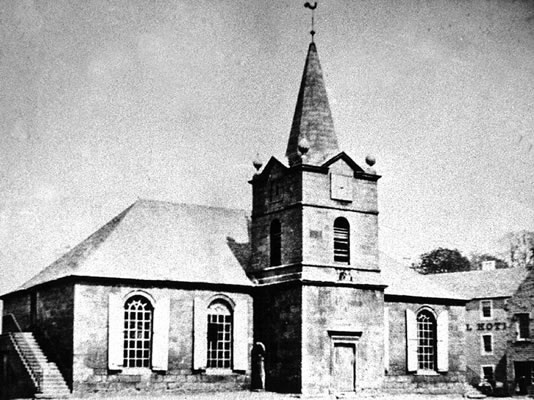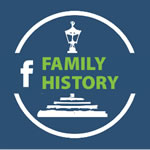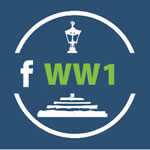Hotels & Inns
By William Findlay
Not much is known about this inn, except that it was built in 1666 and was the principal inn in Cumnock. The street it stood in was once known as Back Street and it is believed that the name of the street was altered to Tower Street after the inn. It's mention in history came in June 1688, when the Covenanting minister David Houston was being conveyed to Edinburgh, by troopers, to stand trial. The soldiers and their prisoner stayed the night at the Blue Tower Inn and continued on their way in the morning of the 20th June, only to be ambushed by Covenanters near the Bello Water just outside Cumnock Parish. The story of the rescue of Rev Houston is given in John Warrick's History of Old Cumnock, Chapter VIII - Cumnock and the Covenant, John Strawhorn also gives the story in Chapter 2 of his New History of Cumnock.
The inn was situated on the south side of Tower Street, between Glaisnock Street and Caddy's Close. No further information is available - possibly it was demolished like most of the older buildings in the vicinity of the graveyard when it was converted into the Square.
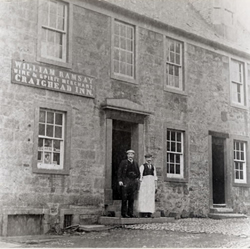 The buildings around the Craighead Inn are regarded as some of the oldest surviving buildings in Cumnock dating from the early 18th century. The Craighead Inn dates from before 1722 when a lease was drawn up for the annual payment of £21 plus 2 hens and 2 loads of coal. It is supposed to have a ghost in the attic.
The buildings around the Craighead Inn are regarded as some of the oldest surviving buildings in Cumnock dating from the early 18th century. The Craighead Inn dates from before 1722 when a lease was drawn up for the annual payment of £21 plus 2 hens and 2 loads of coal. It is supposed to have a ghost in the attic.
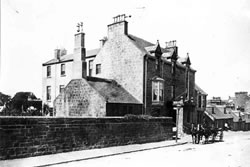 The Dumfries Arms Hotel dates from 25th March 1717 and was originally known as the New Inn or Heid Inn and was an important coaching Inn. It changed its name in 1840 to Dumfries Arms.
The Dumfries Arms Hotel dates from 25th March 1717 and was originally known as the New Inn or Heid Inn and was an important coaching Inn. It changed its name in 1840 to Dumfries Arms.
Residents have included Sir Walter Scott and Robert Burns (who made fun of the Inn by writing Old Cumnock, where beds are as hard as a plank, sir. Cumnock Burns Club, which was founded in 1887, decided to hold its annual celebrations in the Dumfries Arms.
Adam Brown Todd, an outstanding local literary figure, presided at the Cumnock Club’s celebrations for the centenary of Robert Burns’s death in 1896. Mr Todd was a colourful character in the town and was entertained in the hotel to a public luncheon in his honour in 1903.
The Hotel boasted extensive stabling for the coaching horses across the road in Glaisnock Street at Munn's Brae. These played host to many different business, groups and people in later years and finally were demolished in the 60s to make way for new shops. The weather vane in the shape of a cockerel could be seen on top of the gable end of the stable roof and had been there for over a 100 years and was originally on top of the small spire of the former Old Parish Church in the square. The cockerel was given to the Baird institute but no one has seen it for many years.
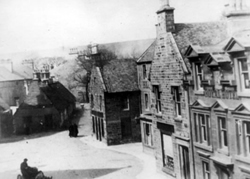 Adjacent to the Royal Hotel, the central portion of the building dates to the mid 1700s and was known as the Black Bull Inn. The Black Bull was a popular meeting and drinking venue. It also hosted many auctions and public meetings. The addition of an extension to the side of the building in 1900 saw the entire building reorganised to cater for increased use. The present Mercat Hotel has now been sold as is now owned by the Royal Hotel who now own most of the block.
Adjacent to the Royal Hotel, the central portion of the building dates to the mid 1700s and was known as the Black Bull Inn. The Black Bull was a popular meeting and drinking venue. It also hosted many auctions and public meetings. The addition of an extension to the side of the building in 1900 saw the entire building reorganised to cater for increased use. The present Mercat Hotel has now been sold as is now owned by the Royal Hotel who now own most of the block.

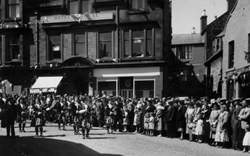 The present Royal Hotel building was erected around 1892 by R J Barrowman, the owner. It boasted "spacious dining, drawing, reading, smoking and billiard rooms - with numerous single and double bedrooms". In 1956 the hotel was bought by Stevenson`s Dairy Farms and has since had a few owners. It has recently undergone extensive additions and renovation work and remains very popular with locals and tourists alike.
The present Royal Hotel building was erected around 1892 by R J Barrowman, the owner. It boasted "spacious dining, drawing, reading, smoking and billiard rooms - with numerous single and double bedrooms". In 1956 the hotel was bought by Stevenson`s Dairy Farms and has since had a few owners. It has recently undergone extensive additions and renovation work and remains very popular with locals and tourists alike.
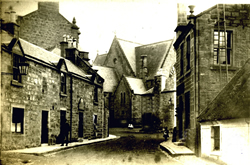 The Tupp Inn was demolished in 2002 after a bad fire which spread through the entire building. The original Inn dated from around 1860 when it belonged to the Weir family. It was made up of several domestic houses joined together. The Tupp in passed through various family members including James Tear who married Agnes Weir. The Tupp Inn remained in the Tear family until 1961when John Weir Tear sold it to Frederick Scott Dick and he in turn sold it in 1965 to A & P Dick Ltd who owned both the Snug Bar and Sun Inn in the Square. The last owner was Alice McConnachie who ran the pub during the 1980s. The pub, known at the time as Jenny Tear's was a popular live music venue and the disastrous fire in 2002 ended the story of the building... but not quite!
The Tupp Inn was demolished in 2002 after a bad fire which spread through the entire building. The original Inn dated from around 1860 when it belonged to the Weir family. It was made up of several domestic houses joined together. The Tupp in passed through various family members including James Tear who married Agnes Weir. The Tupp Inn remained in the Tear family until 1961when John Weir Tear sold it to Frederick Scott Dick and he in turn sold it in 1965 to A & P Dick Ltd who owned both the Snug Bar and Sun Inn in the Square. The last owner was Alice McConnachie who ran the pub during the 1980s. The pub, known at the time as Jenny Tear's was a popular live music venue and the disastrous fire in 2002 ended the story of the building... but not quite!
Raising The Bar
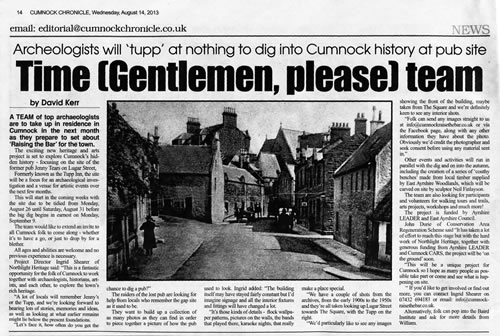
Raising the Bar was a heritage and arts project investigating the local heritage of Cumnock in East Ayrshire - in particular the site of the Tupp Inn - and ran from July 2013 until March 2014.
The archaeological excavation took place in September 2014 and involved local volunteers and over 300 schoolchildren, some of whom created an exhibition at the Baird using finds from the dig for the Kids in Museum's Takeover Day 2013. The project team also worked with local history enthusiasts to research and develop a new Heritage Trail for the town and was influential in the creation of the Cumnock History Group.
Raising the Bar involved many creative activities and events and you can read about the project on the Raising The Bar website http://www.cumnockraisethebar.co.uk
By William Findlay
The building later occupied by the Wheatsheaf Inn (like most of the buildings in the Square) was built around 1800, shortly after the graveyard around the church had been cleared and most of the remains had been removed to the new cemetery in the Barrhill. The building was originally a house of two stories, as were most of the surrounding structures, by 1875 they were still houses and some of them had been owned by the late George Findlay, a farmer at Broomfield in Auchinleck Parish. His son George Findlay, a joiner, occupied one of the houses.
By 1885 the Wheatsheaf Inn had been established, it occupied the lower floor with its main entrance in the Square, the upper floor was converted into a flat with its entrance in Bank Lane. George Findlay owned the property, but the landlord of the Inn was Hugh Robertson. George Findlay died in 1887 and his eldest son, also George Findlay, who was a mechanical engineer, inherited the property. By 1895 George Findlay had become owner and landlord, possibly in conjunction with his mother (Sarah Findlay, nee Hamilton), and remained as such until at least 1925.
George Findlay seems to have left Ayrshire before his death, date unknown. The 1961 Cumnock Chronicle booklet 'Cumnock Banks and Bankers, Shops and Occupants' names Mr James Black as Landlord and Mr John Cree as his predecessor. The Wheatsheaf Inn had been renamed the Snug Inn, and is now incorporated into the neighbouring Sun Inn.
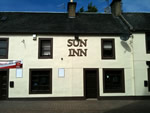 Notes:-
Notes:-
1. The youngest brother of the third George Findlay, William Findlay, was killed in the First World War. Information on him, other members of his family and men and women who served in the war from Cumnock are available on the History Group's WW1 Cumnock Soldiers Blog - you can search for him and others at the right hand side of the page.
2. The Cumnock Bank and Bankers, Shops and Occupants booklet is available for download HERE
Cumnock's Lodging Houses by George Scott
According to Strawhorn’s New History of Cumnock, there were 87 licensed beds in local lodging houses in 1893, and that an average of 50 persons per night used the basic facilities there. These cheap lodging houses fulfilled a need, - to accommodate itinerant workers and vagrants. By 1902 a Model Lodging House had been built in Tanyard Lane, in the area now devoted to part of the Health Centre car park. The word “Model” suggests that it was, in these days, a “state of the art” design for simple accommodation.
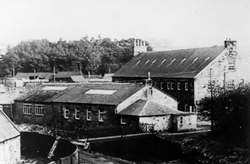 Strawhorn goes on to state that in 1910, besides the Model, there were other eight lodging houses: Carter’s, Bryan’s, Digby’s, Whitten’s, Lorimer’s, Moorhead’s, Phillips’ and Hamilton’s. At a much later date, towards the end of WWII, another model lodging house was opened by Marion Reid at Greenholm, in the building originally occupied by George McCartney & Co, Engineers.
Strawhorn goes on to state that in 1910, besides the Model, there were other eight lodging houses: Carter’s, Bryan’s, Digby’s, Whitten’s, Lorimer’s, Moorhead’s, Phillips’ and Hamilton’s. At a much later date, towards the end of WWII, another model lodging house was opened by Marion Reid at Greenholm, in the building originally occupied by George McCartney & Co, Engineers.
Many of the people who used these lodging houses were vagrants, who walked from town to town. They were usually described as “tramps”. There were many - a census of these tramps was taken in 1903, and the count for Cumnock parish was 88! To supply these people with a bed and basic food was a severe drain on the local council`s finances.
The tramps must have had a very hard life, walking from town to town, carrying their necessarily few worldly goods, and being completely at the mercy of the elements. Hypothermia was not generally known as a killer in those early days, and it is not surprising to discover that many became ill, and had to be removed to the local poorhouse which, in Cumnock`s case, was Kyle Combination Poorhouse in Ayr, where basic care and nursing was administered.
The writer of this little paper visited the two remaining Cumnock Lodging Houses many times in the 1940s, while acting as a Public Assistance Officer. Although they were not at all luxurious establishments, they supplied a roof over the vagrants` heads, some warmth, beds, and simple food. Their Managers maintained a firm discipline, but they also looked after their lodgers.
The lodging houses no longer exist. There was no demand for them from the 1950s onwards as full employment ensured that workers obtained regular work, and a more settled way of life. Nowadays a tramp is a very rare sight.

